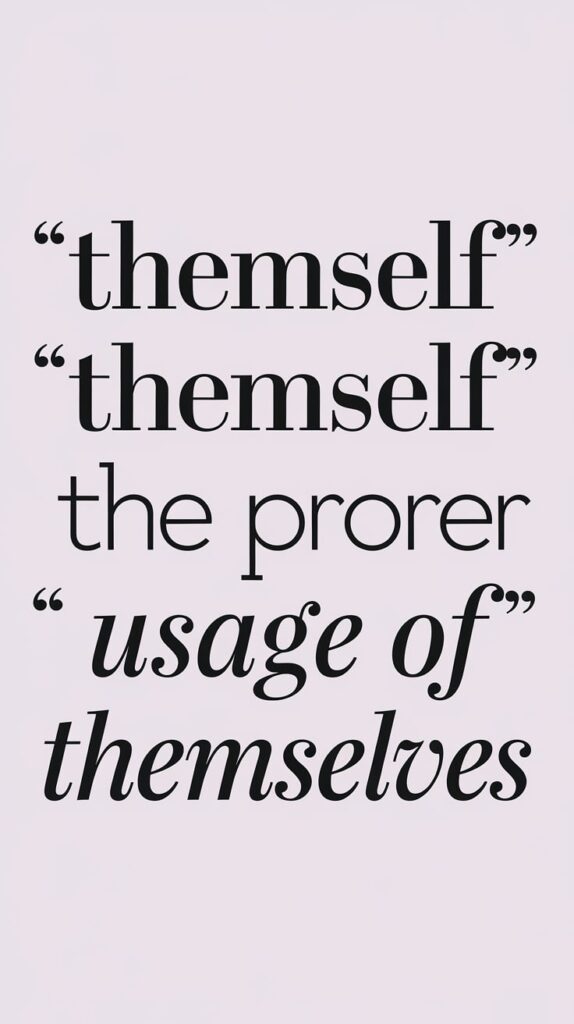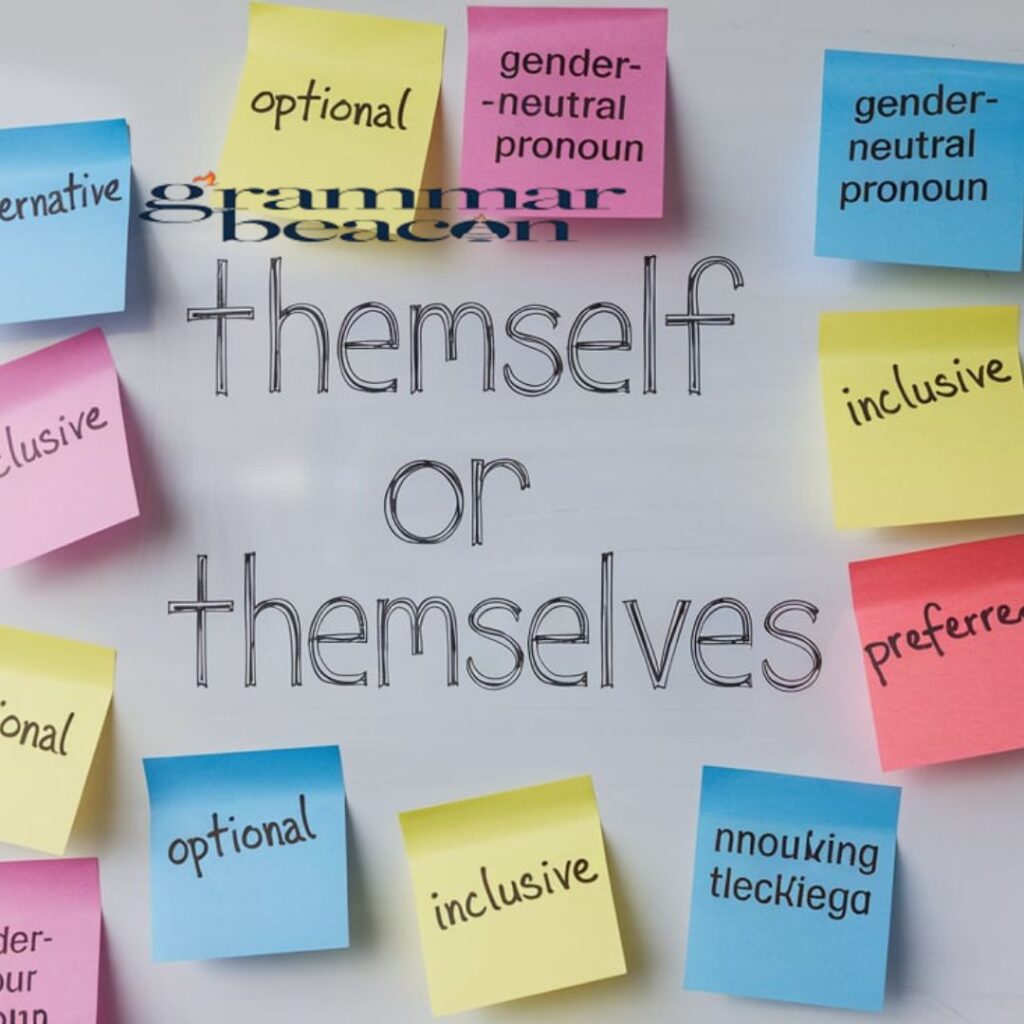The English language is dynamic, evolving with the cultural and social changes that shape our understanding of identity, inclusivity, and expression. A significant part of this evolution is in the usage of gender-neutral pronouns. Among the most discussed pronouns are “themself” or “themselves”, both of which are reflexive pronouns but are used differently based on number, context, and even gender identity. The nuances between “themself” vs. “themselves” can confuse even native speakers, so it is essential to understand their proper use, especially in professional, academic, and personal contexts.
In this comprehensive guide, we will break down the distinction between “themself” and “themselves,” focusing on the contexts in which each is appropriate, the rules governing their usage, examples, and how these pronouns fit into the broader discussion of gender-neutral language.
What Do “Themself” and “Themselves” Mean?

Before diving into themself vs. themselves, let’s first define what a reflexive pronoun is. A reflexive pronoun is used when the subject and object of a sentence are the same. In other words, the action performed by the subject is directed back at itself.
Common reflexive pronouns include:
- I → myself
- You → yourself (singular), yourselves (plural)
- He/She/It → himself/herself/itself
- They → themselves (plural), themself (singular, gender-neutral)
The confusion often arises when dealing with the singular they, which is increasingly used as a gender-neutral pronoun.
The Evolution of “Themself”
While “themself” has been used informally for centuries, it has gained more formal recognition as society moves toward more inclusive language. It is now widely accepted as a reflexive form for singular, gender-neutral subjects—those who do not identify as either male or female.
like to read : 15 Other Ways to Say “Looking Forward to Seeing You” – Grammar Beacon
When to Use “Themself” or “Themselves”
The choice between “themself” and “themselves” primarily depends on whether you’re referring to a singular or plural subject. But it also involves understanding when gender-neutral language applies, particularly in non-binary or genderqueer contexts.
Singular Usage: “Themself”
“Themself” is used when referring to a singular subject who prefers gender-neutral language. In formal writing, “themself” is still a somewhat debated usage, but it is becoming more accepted as a gender-neutral alternative to traditional binary pronouns like himself or herself.
Example Sentences Using “Themself”:
- “Jordan has always been independent and prefers to do things themself.”
- “Sam was so focused on their project, they lost themself in the work.”
- “Bailey believes that they are capable of handling the situation themself.”
Here, “themself” is used to refer to Jordan, Sam, and Bailey, all of whom are singular individuals but may not identify strictly with traditional gender labels.
Plural Usage: “Themselves”
On the other hand, “themselves” is the correct reflexive pronoun used when referring to plural subjects, or when the subject is understood to be plural in nature.
Example Sentences Using “Themselves”:
- “The team members congratulated themselves after winning the championship.”
- “The volunteers took care of the event themselves without any outside help.”
- “The students studied hard and prepared themselves for the exam.”
In these examples, “themselves” refers to multiple individuals—the team members, the volunteers, and the students.
The Importance of Inclusivity in Language
As the conversation surrounding gender identity becomes more inclusive, the use of gender-neutral pronouns like “they/them” (for singular and plural usage) and “themself” has become more widespread. Non-binary individuals, who do not identify exclusively as male or female, may use “themself” in place of “himself” or “herself.”
Usage in Contemporary English

In formal contexts, the use of “themself” might still seem unconventional to some grammar purists. However, in informal and inclusive writing, “themself” is becoming more accepted as the appropriate reflexive form for a singular they.
Example of Non-Binary Usage:
- “Alex decided to take care of the presentation themself, as they were confident in their abilities.”
- “Morgan told me that they are organizing the event themself, without any assistance.”
Inclusivity and the Future of “Themself”
Inclusion and diversity in language are pivotal for embracing people from all backgrounds, particularly those who are non-binary or gender-fluid. Using “themself” correctly is a step towards acknowledging the existence and validity of non-binary identities. As more people adopt these pronouns, “themself” will likely become even more accepted in formal contexts.
Is It Correct to Use “Themselves” in Singular
Contexts?
While “themselves” is traditionally used to refer to plural subjects, it can also be used in a singular context in a gender-neutral sense, particularly when discussing actions or responsibilities in general terms.
Example of Singular “Themselves”:
- “If someone wants to succeed in life, they need to believe in themselves.”
- “Each student must complete the assignment by themselves.”
This form is grammatically acceptable and common in informal English, though “themself” may be preferred when referring to one specific individual.
like to read : Openned Or Opened: Spelling + Examples – Grammar Beacon
Common Mistakes: “Theirselves” vs. “Themselves”
A common mistake many English learners make is confusing “theirselves” with “themselves.” While some dialects and non-standard forms may use “theirselves”, this form is incorrect in formal English.
The Correct Form: “Themselves”

In standard English, “themselves” is always the correct choice, whether you’re referring to one person (in a gender-neutral way) or multiple people.
Example of Incorrect Usage:
- Incorrect: “Each one of them should take care of theirselves.”
- Correct: “Each one of them should take care of themselves.”
Formal vs. Informal Usage of “Themself” and “Themselves”
The choice between “themself” and “themselves” can also depend on the level of formality. In formal writing, especially academic or professional settings, you may still encounter resistance to “themself” and might be expected to use “themselves” even when referring to a singular, gender-neutral subject.
In informal writing, is more likely to be used without raising an eyebrow.
Examples of Themself vs. Themselves in Different Contexts
1. Gender-Neutral Context
In a gender-neutral context, you might use “themself” when the subject is an individual who does not identify as male or female.
- “Jordan took time off to focus on themself.”
- “Alex made sure to finish the project themself, without relying on others.”
2. Plural Context
“Themselves” is always used for plural subjects, even in gender-neutral situations.
- “The team worked together and helped themselves to the snacks.”
- “They traveled to the destination themselves, without any assistance.”
3. Reflexive vs. Emphatic Usage
It’s important to note that reflexive pronouns are used to indicate that the subject of the sentence is doing the action to itself. Emphatic pronouns, on the other hand, emphasize the subject performing the action.
- Reflexive: “They bought a gift for themselves.”
- Emphatic: “They themselves made the decision.”
Key Takeaways:
- “Themself” is used for singular, gender-neutral subjects.
- “Themselves” is used for plural subjects or as the reflexive pronoun for singular, gender-neutral “they.”
- “Theirselves” is considered incorrect in standard English.
- Gender-neutral language helps foster inclusivity and respect for diverse identities.
- Formal usage of “themself” is still evolving, but it is increasingly accepted in both casual and academic contexts.
As we continue to navigate the changing linguistic landscape, the goal should always be to use language that is both grammatically correct and socially responsible. The growing recognition of non-binary identities and the adoption of gender-neutral language forms like “themself” is just one step in making communication more inclusive and understanding of all people, regardless of gender identity.
Understanding and properly using these pronouns not only enhances our grammatical knowledge but also strengthens our commitment to a more inclusive society where everyone’s identity is acknowledged and respected. So, whether you are writing a professional email, engaging in casual conversation, or simply refining your grammar, keep these distinctions in mind to ensure you’re communicating thoughtfully and effectively.
Summary Table of Key Points
| Concept | Themself | Themselves |
| Use Case | Singular, gender-neutral subject | Plural subject or singular gender-neutral reflexive |
| Reflexive | Used when subject and object are the same | Same usage but for plural or generic subject |
| Standard Usage | Acceptable in gender-neutral contexts | Traditionally used for plural, universally accepted |
| Formal/Informal | More commonly used in informal writing | Widely accepted in both formal and informal contexts |
| Correctness | Correct for non-binary individuals | Correct for plural subjects or general gender-neutral usage |
Conclusion

The distinction between “themself” or “themselves” is an important aspect of modern English grammar, especially in the context of gender-neutral language
. As society continues to evolve and embrace a more inclusive understanding of gender, language follows suit by adapting and allowing for the recognition of diverse identities. Both “themself” and “themselves” serve important roles in reflecting this inclusivity, but they are not interchangeable.
It is still relatively new in formal usage, but its adoption is growing as people increasingly recognize the need for language that respects and acknowledges non-binary and genderqueer individuals.
Understanding when and how to use “themself” and “themselves” allows for clearer communication, respecting both grammar rules and individual identity. As language evolves, it is essential to stay informed and adapt to new norms, particularly when it comes to inclusivity.

Steve Rogars is an experienced blogger and language enthusiast at Grammar Beacon. With a passion for clear communication and a keen eye for detail, he shares insights on grammar, writing tips, and language trends. Steve’s engaging style makes learning enjoyable, helping readers enhance their writing skills. When he’s not crafting posts, he enjoys reading, exploring new cultures, and inspiring others to appreciate the beauty of language.







